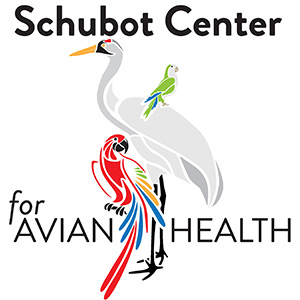Our Mission
The Schubot Center for Avian Health is a multidisciplinary academic group dedicated to solving avian health problems through advanced research. The Schubot Center is housed within the College of Veterinary Medicine & Biomedical Sciences (VMBS) at Texas A&M University in College Station, Texas with a membership of over 75 faculty, students, staff, and clinicians across 7 departments and 3 Colleges/Schools on the Texas A&M University campus. Our mission is to improve the health of birds and the environments in which they live through research, teaching, and outreach. We support laboratory and field studies across Texas, the US, and international locations.

We’re engaged in studies designed to improve the health of both wild and captive birds, with research approaches that span genetics/genomics, infectious disease, epidemiology, parasitology, community science, and conservation science. Our members are also responsible for teaching students at different levels (undergraduate, graduate, DVM professional students) about avian health and conservation. Environmental health is a key component of the “One Health” focus of the VMBS.
A Brief History
The Schubot Exotic Bird Health Center was founded at the VMBS in 1987. It is supported by an endowment created by the late Mr. Richard Schubot of Loxahachee, Florida. Mr. Schubot was an enthusiastic breeder of large parrots, especially macaws and cockatoos. He was frustrated by the disease problems that he encountered when raising these beautiful birds and resolved to do something about it. By donating to Texas A&M University, Mr. Schubot established the Schubot Exotic Bird Health Center dedicated to improving the health of exotic birds.
The first director was Dr. David Graham, who focused on providing diagnostic services to aviculturists. When Dr. Graham retired in 1998, he was succeeded by Dr. Ian Tizard, who has pursued a diverse array of disease and conservation-related research projects.
In 2018, Dr. Sarah A. Hamer was appointed as the Richard Schubot Endowed Chair and director of the Schubot Center for Avian Health. Her leadership position gives her a chance to assist researchers and students in reaching their academic goals, while also expanding on the current scholarship at the center.
“It’s awesome to be surrounded by so many people who are united by their passion for bird health. I value this opportunity to help solve important bird health problems and to provide meaningful training experiences for students,” Hamer said.
“I also have a vision to expand the scope of the types of bird work the Schubot Center tackles.”
 In 2019, the center’s name was changed from “Schubot Exotic Bird Health Center” to the “Schubot Center for Avian Health.” We are excited for the Center name to reflect our broad, inclusive, and expanding work to study birds, ranging from caged birds to wild populations, conservation, genetics, health, and more. Our logo now features a few key species with great significance to the center. First, the endangered Whooping Crane has only a single natural migratory population that winters exclusively here in Texas, and Schubot members have been studying crane disease ecology and have sequenced the genome of the species to open new doors for conservation. Second, the Scarlet Macaw is a large parrot and popular in the aviculture community; researchers with Schubot work on conservation and chick survival of macaws in the wild including a longstanding conservation program based in Tambopata, Peru. Third, the monk parakeet (also known as the quaker parrot) is endemic to South America with many feral/invasive populations across cities in the USA, Europe, and more. The Schubot Aviary has more than 100 monk parakeets that are used for research, teaching, and outreach.
In 2019, the center’s name was changed from “Schubot Exotic Bird Health Center” to the “Schubot Center for Avian Health.” We are excited for the Center name to reflect our broad, inclusive, and expanding work to study birds, ranging from caged birds to wild populations, conservation, genetics, health, and more. Our logo now features a few key species with great significance to the center. First, the endangered Whooping Crane has only a single natural migratory population that winters exclusively here in Texas, and Schubot members have been studying crane disease ecology and have sequenced the genome of the species to open new doors for conservation. Second, the Scarlet Macaw is a large parrot and popular in the aviculture community; researchers with Schubot work on conservation and chick survival of macaws in the wild including a longstanding conservation program based in Tambopata, Peru. Third, the monk parakeet (also known as the quaker parrot) is endemic to South America with many feral/invasive populations across cities in the USA, Europe, and more. The Schubot Aviary has more than 100 monk parakeets that are used for research, teaching, and outreach.
Resources
The Schubot Center for Avian Health has access to generous laboratory space designed for studies on infectious diseases, pathology, genetics, and behavior. The Avian Health Complex includes aviaries, isolation facilities, a laboratory, a clinic, and a classroom. It’s the largest and best equipped of its kind in the United States.



